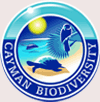Birds of Special Conservation Significance
The National Conservation Law (and previously the Animals Law) protects all wild birds in the Cayman Islands. However, some species are of special conservation significance.
The following birds are subject to Species Action Plans, as part of the Biodiversity Action Plan for the Cayman Islands:
Cayman Parrot
Vitelline Warbler
Brown Booby
West Indian Whistling-duck
Globally threatened species
There are currently three species of birds in the Cayman Islands, of global conservation concern:
West Indian Whistling-duck (IUCN: Vulnerable)
Cayman (Cuban) Parrot (IUCN: Near-threatened)
Vitelline Warbler (IUCN: Near-threatened)
The West Indian Whistling-duck Dendrocygna arborea breeds on Grand Cayman, Little Cayman and intermittently on Cayman Brac. Since the lowest recorded population in 1986 of 200 on Grand Cayman and 45 on Little Cayman, the total population has increased to a maximum of 2,156 birds in 2003, 10-21% of the estimated global population of approximately 10,000 - 20,000 birds (BirdLife International, 2004). This increase is attributed to both the introduction of legal protection of the species and its active enforcement in 1989, causing a reduction in illegal hunting, and the start-up of an artificial feeding programme on Grand Cayman.
A Whistling-duck Action Plan forms part of the Cayman Islands Biodiversity Action Plan.
The Cayman (Cuban) parrot Amazona leucocephala occurs in Cuba, the Cayman Islands and the Bahamas, with a global population estimated at around 10,000 (BirdLife International, 2004). The 1995 total population maximum of 2,400 birds represents 24% of the global population. There are two endemic races on the Cayman Islands: the Cayman parrot on Grand Cayman, with a population estimate in 1995 at 1,408-1,935 birds, and the Cayman Brac parrot on Cayman Brac, with a population estimate of 350-430 birds. This race previously occurred on Little Cayman but was extirpated some time before 1944. Its greatest threat is the ongoing fragmentation and clearance of dry forest.
A Parrot Action Plan forms part of the Cayman Islands Biodiversity Action Plan.
The Vitelline Warbler occurs on the Swan Islands (5 square miles/8 square km) and the Cayman Islands (163 square miles/263 square km), a total range of 168 square miles (270 square km), of which 84 square miles (135 square km) is estimated to be suitable habitat (BirdLife International, 2000). There are three races, two on the Cayman Islands, Dendoica vitellina vitellina on Grand Cayman and D. v. crawfordi on Little Cayman and Cayman Brac, and D. v. nelsoni on Greater Swan Island, which only occurs in half of the 5 square miles (8 square km) total area. The population of nelsoni was most likely reduced by a direct hit from Hurricane Mitch in 1988, which remained over the Swan Islands for 24 hours. Therefore, at least 97% of the global population is resident on the three Cayman Islands with around 67% on Grand Cayman, 22% on Cayman Brac and 11% on Little Cayman. The Cayman Islands’ races are currently not under threat, and are classified as Near threatened due to their small range.
A Vitelline Warbler Action Plan forms part of the Cayman Islands Biodiversity Action Plan.
Restricted-range species
There are four restricted range species with Cayman endemic races:
Vitelline Warbler (IUCN: Near-threatened)
Thick-billed Vireo
Yucatan Vireo
Cuban Bullfinch
The Thick-billed Vireo Vireo crassirostris alleni occurs in forest understorey, secondary woodland and inland shrubland on Grand Cayman and Cayman Brac; it has been extirpated on Little Cayman. On Grand Cayman, the population has declined sharply since 1983 and present distribution is locally fairly common in central and eastern districts. On Cayman Brac, the population has declined in developed areas but otherwise remains common.
The Yucatan Vireo Vireo magister caymanensis is confined to Grand Cayman; it occurs throughout, most commonly west of Savannah, where it breeds in the upper levels of the dry and black mangrove forest.
The Cuban Bullfinch Melopyrrha nigra taylori is confined to Grand Cayman. It is scarce to absent in western Grand Cayman where the decline in numbers began around 1990 in line with increased development/habitat loss. It is locally common at North Side, the Mastic Reserve, and in forest and secondary woodland in the central and eastern districts.
Biome species
The Cayman Islands form part of the Greater Antilles biome (NEO 07) with five species, all with endemic Cayman subspecies:
Caribbean Dove Leptotila jamaicensis collaris,
West Indian Woodpecker Melanerpes superciliaris caymanensis
Western Spindalis Spindalis zena salvini
Loggerhead Kingbird Tyrannus caudifasciatus caymanensis
Greater Antillean Grackle Quiscalus niger caymanensis and Q. n. bangsi.
SOURCE:
Bradley, P., Cottam, M., Ebanks-Petrie, G. and Solomon, J. (2006) Section: Cayman Islands, in Sanders S.M., ed. Important Bird Areas in the United Kingdom Overseas Territories. Cambridge, UK: BirdLife International)
REFERENCE:
For more information on the birds of the Cayman Islands, see
Bradley, P. E. 1995. Birds of the Cayman Islands
Bradley, P. E. 2000. The Birds of the Cayman Islands
Raffaele et al. 2003. A Guide to the Birds of the West Indies.







